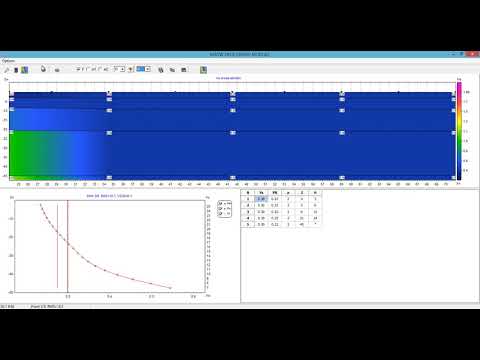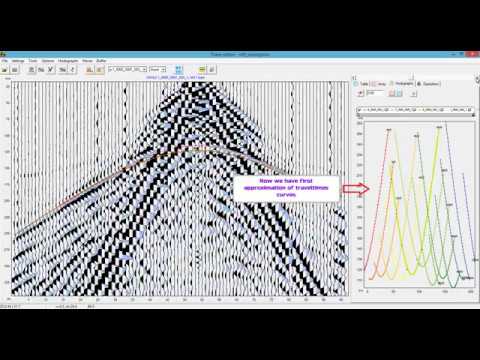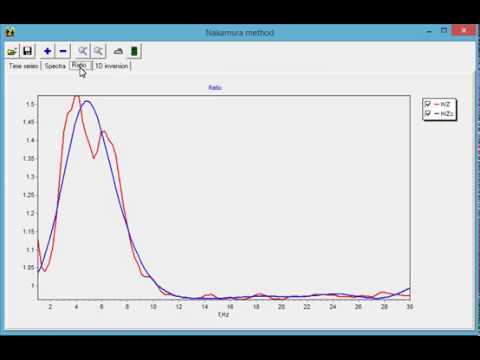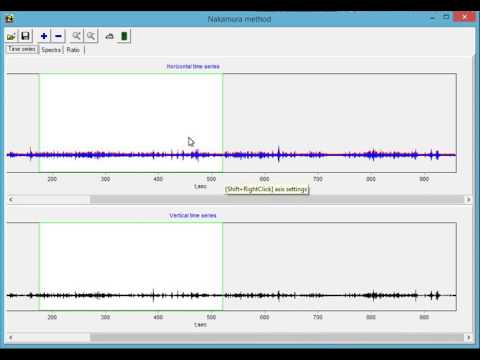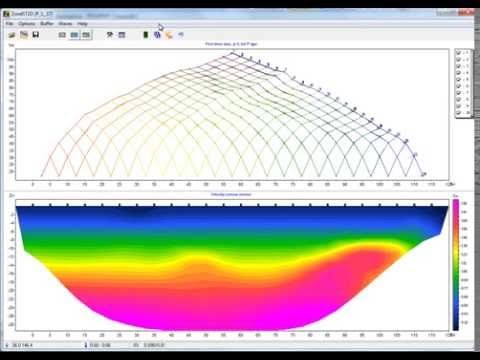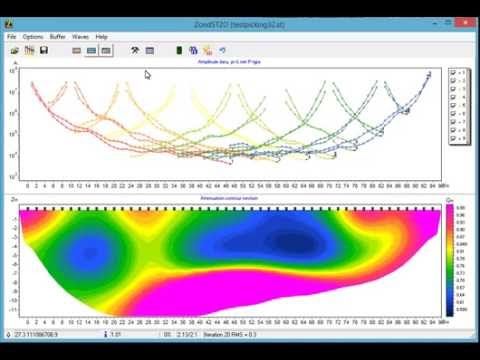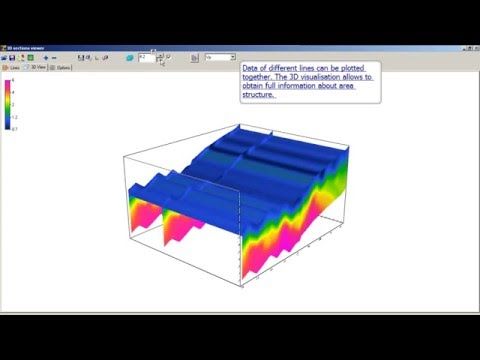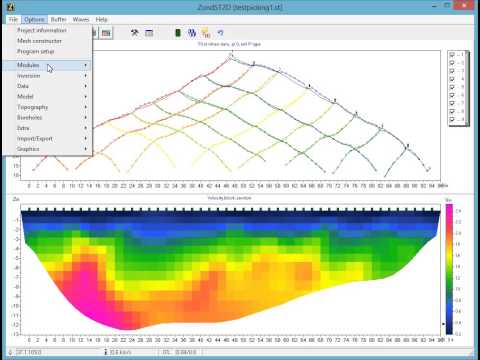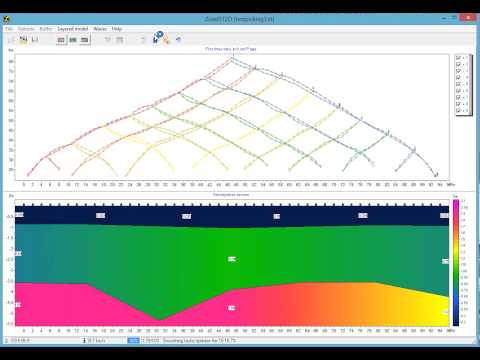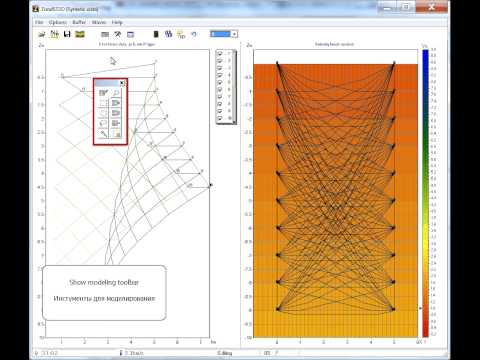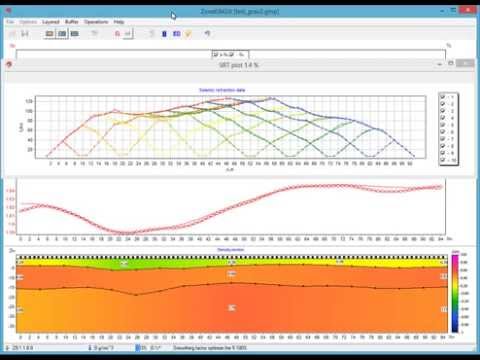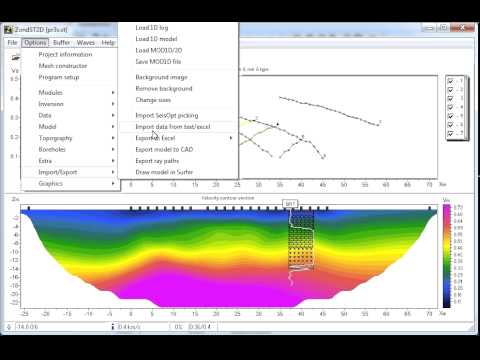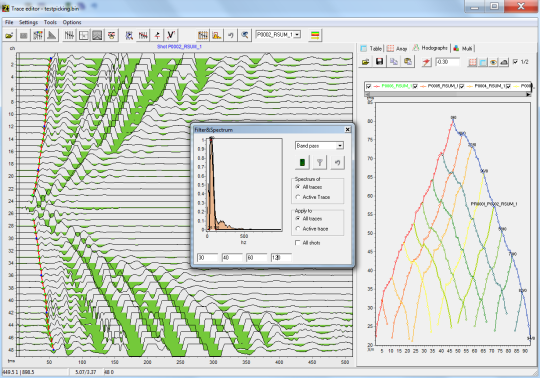ZondST2d — 2D seismic data processing and interpretation software
ZondST2D is designed for 2D interpretation of seismic tomography data on refracted and reflected waves (land, cross-borehole and water variants).
ZondST2d is a part of Zond Software family of programs with unified interface and data processing sequence. It’s easy to start working in ZondST2d if you have experience of processing in any other Zond product. Compatibility of data formats inside Zond Software package helps to combine geophysical data from different methods and sources in order to obtain much more stable and reliable geophysical models.
Zond Software family:| ZondST3d | Designed for 3D inversion of seismic tomography data (first breaks) and refraction seismic. |
| ZondIP1d | Designed for 1D inversion of VES and VES-IP data. |
| ZondRes2d | Designed for 2D interpretation of electrical resistivity and induced polarization tomography (ERT and IP) data |
| ZondRes3d | Designed for 3D inversion of resistivity and induced polarization data in land, borehole and marine variants. |
| ZondProtocol | Designed for creation of protocols, measurement control and visualization of ERT measurements and data quality assessment. |
| ZondMT1D | Designed for 1D inversion of magnetotelluric (MT), audiomagnetotelluric (AMT) and radiomagnetotelluric (RMT) data. |
| ZondMT2D | Designed for 2D inversion of MT, AMT and RMT data. |
| ZondGM2d | Designed for 2D multiprofile inversion of gravity and magnetic data. |
| ZondGM3d | Designed for 3D inversion of gravity and magnetic data. |
| ZondTEM1d | Designed for 1D inversion of transient electromagnetic (TEM) data for various observation systems with lines and loops. |
| ZondTEM2d | Designed for 2D inversion of EM soundings data in time and frequency domain. |
| ZondSP2d | Desined for 2D inversion of self-potential data. |
| ZondST2d | Designed for 2D seismic tomography interpretation (refracted waves). Modules: MASW, Attenuation tomography, Layered media, Anisotrophy. Nakamura(HVSR) is included. |
| ZCGViewer | Designed for calculation and visualization of apparent resistivity graphs obtained with various electric survey systems. |
Software requires OS Wndows 98 or later version.
Following modules are included in ZondST2d:- Seismic tomography
- First arrival picking on seismic gathers
- MASW-ReMi — surface waves data processing and interpretation
- Refraction waves forward modeling and inversion in arbitrary layered medium
- Amplitude inversion
- Seismic tomography on the arrival times of reflected waves
- Module for Nakamura method
The seismic tomography module is a ready-to-use solution for seismic tomography that solves a wide range of problems from mathematical modeling and sensitivity analysis to inversion and field data interpretation.
Shortest path's algorithm is used to solve the forward problem of ray tracing. Algorithm is characterized by high speed calculations and controlled accuracy. The method allows to calculate the shortest path of refracted wave. The combination of the shortest ray paths from the source and receiver to the reflector allows to generate a reflected wave path for each boundary. A section of the boundary with minimum total passing time from the source and receiver is selected as a reflection point.
Ray tracing algorithm is implemented in three ways: 1. Ray approximation. Constant velocity inside a cell. 2. Ray approximation. Velocity inside a cell changes linearly. Velocities are defined in nodes. 3. Modeling of a variable radius ray channel. Velocity inside a cell changes linearly. Velocities are specified in nodes.
Seismic tomography module allows to obtain velocity cross-sections for both pressure and surface waves. Sources and receivers can be placed on the ground, water surface, seabed or in boreholes. It is also possible to use the module for interpretation of vertical seismic profiling (VSP) data. Additionally to velocity cross-sections estimation, reconstruction of velocity anisotropy distribution has been implemented. The program uses the simple version of the seismic velocity anisotropy ratio — Vx/Vz.
First arrival picking on seismic gathers module interface is designed to simplify and automate the process of picking of first arrivals. Module provides a variety of visualization methods and immediate access to the most common functions. The user can simultaneously pick several types of Vs, Vp refracted waves and up to 3 reflected waves. Data processing is optimized for joint use of P- and refracted S-waves.
Refraction waves forward modeling module is designed to obtain arbitrarily layered sections according to the refracted (or reflected) waves method. The velocity section is defined by a set of layers with free layers geometry and arbitrary velocity distribution along the profile in each layer. Complexity of horizon geometry is controlled by the number of nodes. Any layer may be reflective and refractive, or refractive only. The application implements a precise solution for an arbitrary layered medium. The ray is passing according to Fermat principle, which correctly describes the physics of the process, unlike the t0 method, where the wave always slides on the refraction edge. The module allows modelling arrival times of the refracted and reflected waves and to solve the inverse problem of observed times both combined and separately. Joint inversion of VES, MT, AMT, RMT, TEM data, gravity and magnetic surveys is available in the module.
The surface wave dispersion analysis,implemented in the MASW module enables to obtain Vs velocity profiles from field data. The program provides a full cycle of data processing from dispersion curves estimation up to velocity section building. Multi-modal inversion is also available.
The Amplitude Inversion module implements the Attenuation tomography algorithm and allows to obtain a section of the Q attenuation parameter from the values of the first break amplitudes. The problem solution is based on a preliminarily obtained velocity section. The first break amplitudes’ values are picked simultaneously with times.
Additional GraviMagnetic module provides efficient combining of gravity and magnetic surveys with velocity section with single frame. Frame based on seismotomographical section is filled with gravity and magnetic data automatically or manually.
Special Nakamura application provides spectra estimation, microseisms analysis, performs generation H/V ratio spectra and modeling of 1D Vs vertical sections.
Detailed information about ZondST2d functions can be easily found in User Manual and in video tutorials. Also, you can get demo version by link given below.
Configurations:
Three versions of ZondST2d are available:
ZondST2d Full version — all functions and modules are included.
ZondST2d Refraction version — configuration with all functions needed for ground seismic tomography data processing.
ZondST2d MASW version — includes all functions for surface waves processing and Nakamura method.
ZondST2d versions and their functions:
| Modules and functions | Full version | Refraction version | MASW version |
| Seismic tomography module for land data processing | + | + | - |
| Seismic tomography module for land, borehole, cross-borehole and marine data processing | + | + | - |
| Anisotropy calculation | + | + | - |
| First arrival picking module | + | + | + |
| MASW module — surface wave data processing and interpretation | + | - | + |
| Refraction waves forward modeling module — an arbitrary layered medium | + | + | - |
| Amplitude inversion | + | + | - |
| Seismic tomography on the arrival times of the reflected waves | + | + | - |
| Nakamura method | + | - | + |
| Joint inversion with electromagnetic (VES, MT, AMT, RMT, TEM), gravimetric and magnetic data | + | + | - |
